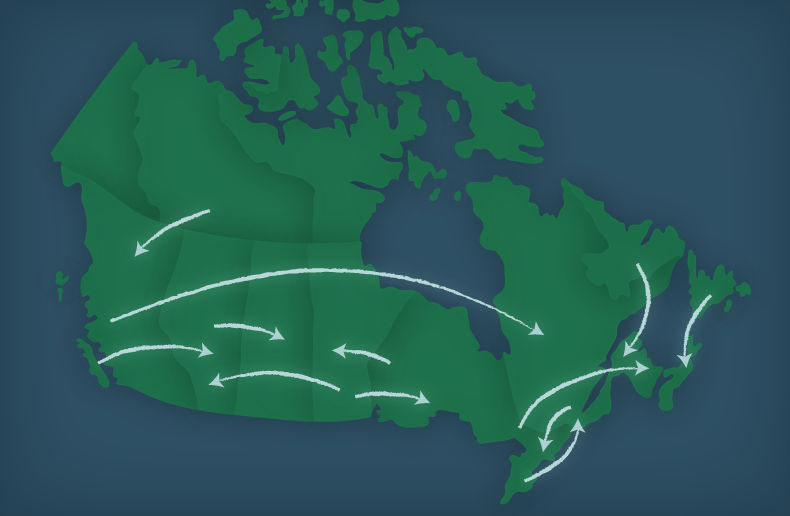In a market where many managing general agencies are struggling with sales volume pressures from insurers, technology and service expectations from advisors, and profit margins are being squeezed from all sides, the only way to survive and thrive is to grow bigger fast, a number of Canada’s leading MGAs told The Insurance Journal.
One of the main strategies to achieve this goal is through consolidation. The bigger firms are buying up the smaller ones, many of which are falling by the wayside in this increasingly demanding business climate.
One of the main challenges for these smaller firms is meeting carrier volume requirements. For example, an insurer might require sales of $250,000 in life first year commissions to maintain an MGA’s contract. Whereas in the past, some companies may have been patient with MGAs who were not meeting their sales targets, MGAs interviewed report that there is now more pressure to meet the requirements or lose the contract.
Many other factors, such as technology demands are also putting heavy pressure on MGAs, explains Terri DiFlorio, president of Hub Financial, Hub Capital and the Canadian Association of Insurance Life Brokerage Agencies (CAILBA). To keep and attract advisors, not only do MGAs need to acquire the advanced technology systems that allow advisors to track their business on-line, they also need the on-staff expertise to keep the systems working optimally. This can be cost prohibitive for many firms, she notes.
Another factor is that profits are down for MGAs dealing with downloading from insurers and increasing service demands from advisors. “Margins are tight in this business for sure,” she says.
Growing bigger to get economies of scale to remain competitive under these conditions is a clear strategy for the majority of MGAs. HUB, already a huge player, definitely has plans to grow, Ms. DiFlorio says. “We would definitely like to do more acquisitions.” Hub Financial has acquired 18 MGAs since doing its first acquisition 10 years ago. It’s last acquisition was announced in July when Hub acquired Standard International Underwriters (SIU) based in Edmonton.
To give an idea of just how big Hub Financial has grown, Ms. DiFlorio says that the company processed 32,000 life applications last year and did just under 500,000 trades on the investment side (mutual and segregated funds). It currently works with 3,000 active independent producers with active being defined as anyone who has done business through Hub in the past 12 months.
After acquiring so many MGAs, she says Hub has acquired the scale it needs to satisfy sales volume requirements with all its insurers and has also learned that the most important criteria in identifying a good acquisition is the MGAs’ culture and strategic fit. Hub is experiencing significant organic growth (5% in 2006 and 9.6% in Q1 2007), so it is in no rush to make acquisitions, she adds. That said, if the right opportunity came along “we’d jump at it.” She adds that a couple of new potential acquisitions are presently in the early stages of discussion.
The right fit for Hub Financial would include such considerations as technology. Hub has a heavy focus on technology. An MGA whose advisor network not used to working via web-technology might not be a good fit.
John Hamilton, president and owner of Financial Horizons Group based in Kitchener, Ontario, is in full-on acquisition mode, having done half a dozen in the last two years and with another five or so in various stages of negotiation. His MGA currently does over $10 million of life premiums, new sales, and more than $200 million in segregated fund new sales annually through a network of about 850 active brokers, which he defines as producers who gave the MGA five pieces of business or more in 2006. His growth target “is 20% a year at minimum.”
Mr. Hamilton says pressures from insurers on volume requirements, that smaller players are having difficulty meeting, is helping the larger firms looking for acquisition opportunities. Mr. Hamilton and other MGAs interviewed, say the life companies are letting it be known that they would prefer to have fewer points of distribution selling higher volumes to reduce their costs. They would rather have around 40 MGAs instead of the current, approximately 120, says Mr. Hamilton. He points to Sun Life who has chosen to deal with just over a dozen MGAs.
Technology is key
Like Ms. DiFlorio, he also points to technology as a key driver of consolidation in the industry. “The smaller MGAs don’t want or can’t afford to adopt the technology that brokers want…It’s a transition period that the industry is going through.”
The size of the MGAs that Financial Horizons has acquired so far, and the ones it is looking to acquire, is about $2 million in life premiums and $20-$25 million in segregated funds per year and have contracts with two to three insurers.
Why is Financial Horizons pursuing this acquisition strategy? To support its contracts with insurers, pick up advisors and expand its network of regional offices, Mr. Hamilton explains. Some MGAs may be small, but they may have a good concentration of business with one insurer, enabling the firm to boost its volume with that insurer and support its contract.
When acquiring, Financial Horizons has a couple of approaches. Some MGAs retain ownership of their old books of business, but take on the Financial Horizon name in a franchise arrangement and become a branch office. “Others sell the old book and move on. In this case we merge the book into an existing regional office.”
Presently doing up to 85% of its business in Ontario, Financial Horizons is looking to expand in Western Canada primarily and in Northern Ontario. It is licensed across Canada except for Quebec. However, it was going through the licensing process in Quebec, with the granting of this license expected imminently.
Mr. Hamilton says many MGAs are feeling the need to go national. “The Western MGAs are coming East and the Eastern MGAs are moving West.”
One of the Eastward bound MGAs is Winnipeg-based Daystar Financial Group. Rene Pereux, owner/president of the company, says Daystar is in the range of $10 million in first year commissions, making it one of the bigger players in the country. Created five years ago, the firm has so far acquired two other MGAs, a firm in the Maritimes and Greenstone Financial Solutions in Mississauga last year. Daystar is also in different stages of due diligence on the road to acquiring three other MGAs.
“We absolutely consider ourselves a consolidator…We will continue to grow organically and through acquisitions. We expect double digit growth for quite some time into the future,” he says.
The company is eyeing small and mid-sized MGAs for acquisition. “Our strategy is to be in locations where we want a bigger part of the market share… Our long-term strategic plan is to be a national presence.”
Bruce Hammond, president of Performins Canada, an MGA consolidator that has so far acquired five Ontario MGAs since incorporating in 2004 – the latest acquisition was Toronto-based Pan Financial Insurance Agencies which was announced last January. The company presently has a network of some 1200 active advisors. Mr. Hammond says the company is now looking outside of Ontario for acquisitions. It expects to complete another purchase before the end of August, likely in Vancouver.
Performins’ goal is to be across Canada. Originally, its business plan called for 10 acquisitions within five years and the company is on track to achieve this, says Mr. Hammond.
Access to capital
Mr. Hammond says that while everyone is talking about consolidation, he doesn’t believe that a great deal of true consolidation is happening. “A consolidator goes in, buys companies and puts them together.” Most MGAs, he says, lack the capital to finance acquisitions. “The question is where is the cash coming from?”
Performins has financial backing from the VentureLink Financial Services Innovation Fund, which owns a stake in the MGA. “A lot of people who will acquire your company will pay you out of shares…pay out of income. The difference is we pay cash.” Part of the deal may involve earn outs, he adds, but there is “a big lump sum initially.”
Ottawa-based R.G. Packman and Associates is also in the market for acquisitions. President of the firm, Robert Packman, says his company has acquired three companies in the last three years. The MGAs current markets include Ontario, Quebec and the Maritimes and his firm does “north of $6 million in first year commissions.”
Mr. Packman says he is presently looking at two other acquisition targets, one in Toronto and the other in Quebec. He calls an acquisition strategy “a beautiful thing” that results in overhead cost reductions and a healthier bottom line.
While he is looking for substantial growth in the next five years, Mr. Packman says expanding nationally is not a priority. Instead, he is seeking growth for his firm in its “natural markets” in the vicinity of their present locations, primarily Ontario and Atlantic Canada.
One of the reasons that he believes growth is important is that larger MGAs have the resources to provide the training and specialized support that advisors want and need. “You have to have a value proposition that gives brokers a reason to deal with you.” Examples of his firm’s value proposition include having specialists on staff to assist advisors, providing professional development days, etc. “You can’t just be a black hole for people to drop applications into,” he remarks.
Strategic alliances
Simon Jackson, president of Simon L. Jackson Insurance Brokerage, says he hasn’t done an MGA acquisition in six years and is not looking to do one yet. He estimates his firm is one of the top five MGAs in Ontario and has about 600 active advisors. “We can hold our own in any weather, whatever storm will come.”
However, he is looking for strategic alliances to mutually strengthen both firms and boost overrides. His firm is in the process of consolidating such an arrangement now. A smaller MGA that had difficulty maintaining its three or four contracts joined as an associate general agent. “We’re interested in other alliances of the same style.”
BridgeForce Financial Group is another example of a strategic alliance on a very large scale. Six MGAs came together under the BridgeForce banner as equal partners about a year and a half ago. BridgeForce doesn’t plan to bring on any more partners, said Don Frost, the group’s president, but intends to pursue growth organically and potentially by acquiring MGAs. “We’re very open to acquisitions… We’re always on the lookout, always interested in the market.” He says BridgeForce hasn’t made any acquisitions this year because it has been focused on consolidating the group.
BridgeForce does the bulk of its business with a group of eight to ten preferred suppliers. It has chosen these companies based on financial strength, product offering, service and support. “We have many, many more contracts, but we’re anxious to have strong partnerships.”
Mr. Frost says that while he believes niche players will continue to exist in the market, he also thinks that it is generally true that MGAs must get bigger to survive. “Clearly the trend is toward bigger. It’s being demanded by the insurers. They’re interested in getting more business from fewer MGAs.”
In years past, companies use to hand out MGA contracts “all over the place. This is just not happening anymore…”
United MGA is another grouping based on the alliance model. It is a corporation started in 1999 by 10 founding members. Now there are 27 partners and 33 offices in the network. All the partners retain autonomy over their individual operations, but they are also partners in United MGA which has six of its own contracts with insurers and has a head office in Oakville, Ontario.
Members can put business through United MGA or through their own independent operations, explains Lawrence Fuller who is president of the company and also president of MGA Canada Loyal Financial. Together all the members do a total of $25 million FYC, he says.
The MGAs work together “to maximize our potential, share ideas and strengthen each other.” He gives an example of how one of the Quebec members, who has a background in financial planning, has provided technology tools that all the members’ advisors are welcome to use for client financial analysis and planning.
While they continue to operate their separate MGAs, Mr. Fuller says the group is aiming to do business more closely together, for example by potentially adopting the same back-office technology with the option of doing all the members’ processing through this system. At the same time they will maintain “that wonderful ingredient of being independent.”
Looking to the future, Mr. Fuller believes that with all the amalgamation going on among insurers, there will be only a handful of large carriers left in years to come. He adds that it wouldn’t surprise him if the same thing happens in the MGA market. If this happens, he wants United MGA to survive. “We are positioning ourselves to be one of those distribution systems.”
Mr. Fuller admits that while some insurers have embraced the United MGA model, others either don’t understand what it is all about, or are not aware of the company yet. Part of this reason is that the company hasn’t done much marketing yet and has mostly grown through word of mouth. But now the firm is at the size and strength that it wants to raise its visibility through marketing efforts. “We’re going to tell our story.”
The group is also now looking to sign up more good quality MGA members to raise production levels. Mr. Fuller’s vision is to have 50 to 60 members. He believes that MGAs can do better together than competing against each other. “It’s time we linked arms and stood together.”
Mid-sized players aggressive
Kevin Cott, president of Toronto-based Qualfied Financial Services (QFS), sees the fiercest competition in the market is among mid-sized MGAs looking for increased scale. He says his company is presently in the top quartile of mid-market and is “is aiming for the top” with aspirations to be among the top five or six players in Canada, or in the top 10% of the mid-market.
In business for 10 years, QFS has grown at a compound rate of more than 20% per year every year and “it’s still not enough,” he says. The company needs to triple its volume in the next five to seven years to reach the top slice of the mid-market and multiply its sales volume by five to seven times to be among the largest players.
To do this, QFS has an aggressive acquisition strategy. “The reality is that it is almost impossible to grow organically at this time. If you want to become big, you must grow through acquisitions.”
He says, however, that he hears more talk of consolidation in the market, than is actually taking place. “I don’t think it is happening at the pace people think it is.” But, with the aging MGA market, it is bound to accelerate in the coming years, he adds.
According to Mr. Cott, even the talk of consolidation alone is having an impact. The discussion about consolidation in the brokerage community, as well as the existence of large players such as Hub Financial and BridgeForce, have created pressure on others, he explains. These two factors are causing brokers to consider their long-term relationships with MGAs, making them question whether they should keep doing business with ‘John Smith Insurance Agency’ or develop a relationship with an MGA more likely to be around several years from now.
So far, QFS has completed one acquisition in Toronto in 2005 and is actively looking for other opportunities. Mr. Cott specifies, however, that his firm does not want to be classed as a consolidator. He says consolidators in any industry are all about dismantling organizations and assimilating the assets into their own infrastructure. QFS’ objective is to continue working with the acquired company, supporting their current business philosophies and adding to what they have. This will strengthen the relationship with the advisors, he says.
Compensation lower
Mr. Cott says economic pressures on MGAs are behind the need to grow. Costs have risen for MGAs with regard to compliance requirements, training, recruitment, etc., but compensation has not risen, he points out. “They (insurers) are not paying anymore than 10 years ago. In fact, they are paying less.”
Preferred underwriting, he explains, has lowered compensation to advisors and, consequently, to MGAs. Preferred underwriting means product pricing is around 50% lower, so commissions are that much lower as well.
As a result, the advisors are asking MGAs for higher overrides, which puts pressure on the MGAs to get bigger so they can tap into volume bonuses from insurers to be able to afford to pay more to their advisors. “We’re having to put out significantly more effort to create the same income as 10 years ago,” he says.
Can the small survive?
Is there still room for small MGAs in the market? Most MGAs interviewed said yes, as long as they can offer a unique value proposition to advisors.
Byren Innes, senior vice-president of industry research company NewLink Group, says smaller firms who position themselves as specialty niche players who are not competing in the mainstream can thrive. He gives the example of Toronto-based Hunter McCorquodale a specialist in the hard-to-insure, life and disability market as an operation that is fulfilling this criteria. “On true volume, they don’t count. On true service, they do count and, they are doing very well.”



